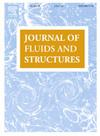Surface bulk cavity formation on flat isotropic plates subjected to near-field underwater explosions
IF 3.5
2区 工程技术
Q1 ENGINEERING, MECHANICAL
引用次数: 0
Abstract
The formation of surface bulk cavities on isotropic flat plates due to the detonation of a near-field underwater explosive (UNDEX) has been computationally investigated. Experiments were performed in an air-backed condition for polycarbonate plates of 6.35 mm thickness, and 12.70 mm thickness, as well as steel plates 12.70 mm in thickness. Moreover, three distances between the explosive and targets were selected. Numerical simulations were performed with the fully coupled Eulerian–Lagrangian fluid structure interaction code Dynamic System Mechanics Advanced Simulation (DYSMAS). Initially, the numerical simulations were validated with the experimental data. Once validated, the numerical simulations were utilized to explore a wide range of structures and standoff distances. Results show that a surface bulk cavity forms on the plate when the centerpoint out of plane velocity of the plate reaches its maximum magnitude while the plate displaces towards the UNDEX gas bubble. Moreover, plates with equal flexural stiffness attained comparable maximum surface bulk cavity volumes. Additionally, the maximum surface bulk cavity volume exponentially decreases as the plate’s flexural stiffness increases. The maximum volume attained by the UNDEX gas bubble is directly related to the timing in which the surface bulk cavity begins to form on the plate. This timing is related to the plate’s flexural stiffness, as well as the plate’s natural frequency. The loading on the plate resulting from the collapse of the surface bulk cavity and the UNDEX gas bubble are influenced by the plate’s flexural stiffness.

近场水下爆炸作用下平面各向同性板表面体腔的形成
本文对近场水下炸药(UNDEX)爆炸后各向同性平板表面体空腔的形成进行了计算研究。在气背条件下对厚度为6.35 mm、12.70 mm的聚碳酸酯板和厚度为12.70 mm的钢板进行了实验。此外,还选择了炸药与目标之间的三个距离。采用欧拉-拉格朗日流固耦合程序DYSMAS进行数值模拟。首先,数值模拟与实验数据进行了验证。一旦验证,数值模拟被用于探索更大范围的结构和距离。结果表明,当板的中心点离面速度达到最大时,板向UNDEX气泡方向位移,在板上形成表面体空腔。此外,具有相同弯曲刚度的板获得了相当的最大表面体积空腔体积。此外,随着板的抗弯刚度的增加,最大表面体腔体积呈指数减小。UNDEX气泡所达到的最大体积与板上表面体腔开始形成的时间直接相关。这个时间与板块的弯曲刚度以及板块的固有频率有关。板的弯曲刚度对板表面容空腔塌陷和UNDEX气泡产生的载荷有一定的影响。
本文章由计算机程序翻译,如有差异,请以英文原文为准。
求助全文
约1分钟内获得全文
求助全文
来源期刊

Journal of Fluids and Structures
工程技术-工程:机械
CiteScore
6.90
自引率
8.30%
发文量
173
审稿时长
65 days
期刊介绍:
The Journal of Fluids and Structures serves as a focal point and a forum for the exchange of ideas, for the many kinds of specialists and practitioners concerned with fluid–structure interactions and the dynamics of systems related thereto, in any field. One of its aims is to foster the cross–fertilization of ideas, methods and techniques in the various disciplines involved.
The journal publishes papers that present original and significant contributions on all aspects of the mechanical interactions between fluids and solids, regardless of scale.
 求助内容:
求助内容: 应助结果提醒方式:
应助结果提醒方式:


